 This Spring Break, I had the privilege of participating in EcoHouse’s fourth annual service trip to Milam Creek and Glen Rogers in Wyoming County, West Virginia. Initiated by former EcoHouse program coordinator Brigid Belko, this Alternative Break assists the Friends of Milam Creek on various service projects. This organization is composed of local volunteer residents who seek to revitalize their community. In their own words: “Aspiring to restore Milam Creek and its adjacent neighborhoods to its former glory with clean, lush waters and creek beds, Friends of Milam Creek is uniting the community through collaborative action toward a healthier environment and better tomorrow.”
This Spring Break, I had the privilege of participating in EcoHouse’s fourth annual service trip to Milam Creek and Glen Rogers in Wyoming County, West Virginia. Initiated by former EcoHouse program coordinator Brigid Belko, this Alternative Break assists the Friends of Milam Creek on various service projects. This organization is composed of local volunteer residents who seek to revitalize their community. In their own words: “Aspiring to restore Milam Creek and its adjacent neighborhoods to its former glory with clean, lush waters and creek beds, Friends of Milam Creek is uniting the community through collaborative action toward a healthier environment and better tomorrow.”
The Appalachian Community
 Dvon Duncan, Friends of Milam Creek’s Secretary, and Donna Burner, Chair, welcomed us all warmly and gave an introduction to the town and its situation. The Milam, McGraws, Ravencliff, and Glen Rogers region of the county is one of many small, relatively isolated communities in southern West Virginia that has been severely impacted by the coal industry over the last century. For decades, the timber, gas, and coal industries have held a virtual monopoly on the region. At one time mining companies forced workers to buy all provisions from company stores, preventing the growth of local businesses. Most men in the area have worked in the mines at some point in their lives, since there are few other jobs available to them. In addition to very poor working conditions, the mines have polluted the surrounding watersheds with heavy metals and coal residue. As a result of landscape modification, the narrow creek and river valleys where most towns lie have been prone to massive and deadly floods.
Dvon Duncan, Friends of Milam Creek’s Secretary, and Donna Burner, Chair, welcomed us all warmly and gave an introduction to the town and its situation. The Milam, McGraws, Ravencliff, and Glen Rogers region of the county is one of many small, relatively isolated communities in southern West Virginia that has been severely impacted by the coal industry over the last century. For decades, the timber, gas, and coal industries have held a virtual monopoly on the region. At one time mining companies forced workers to buy all provisions from company stores, preventing the growth of local businesses. Most men in the area have worked in the mines at some point in their lives, since there are few other jobs available to them. In addition to very poor working conditions, the mines have polluted the surrounding watersheds with heavy metals and coal residue. As a result of landscape modification, the narrow creek and river valleys where most towns lie have been prone to massive and deadly floods.
Now, as coal production declines in the face of natural gas and renewable energy, more layoffs and few alternative job options have resulted in a high unemployment rate and a general feeling of hopelessness for the once thriving communities. And on top of all this, the area is suffering a ‘brain drain,’ as those who can afford higher education often move away and don’t return. Dvon stressed that our work here is essential to providing a place where people young and old can safely play and exercise. There are no other sources of recreation for this community except Milam Creek Park. An important goal for Friends of Milam Creek is to re-educate their community about the importance of taking care of all their natural resources.
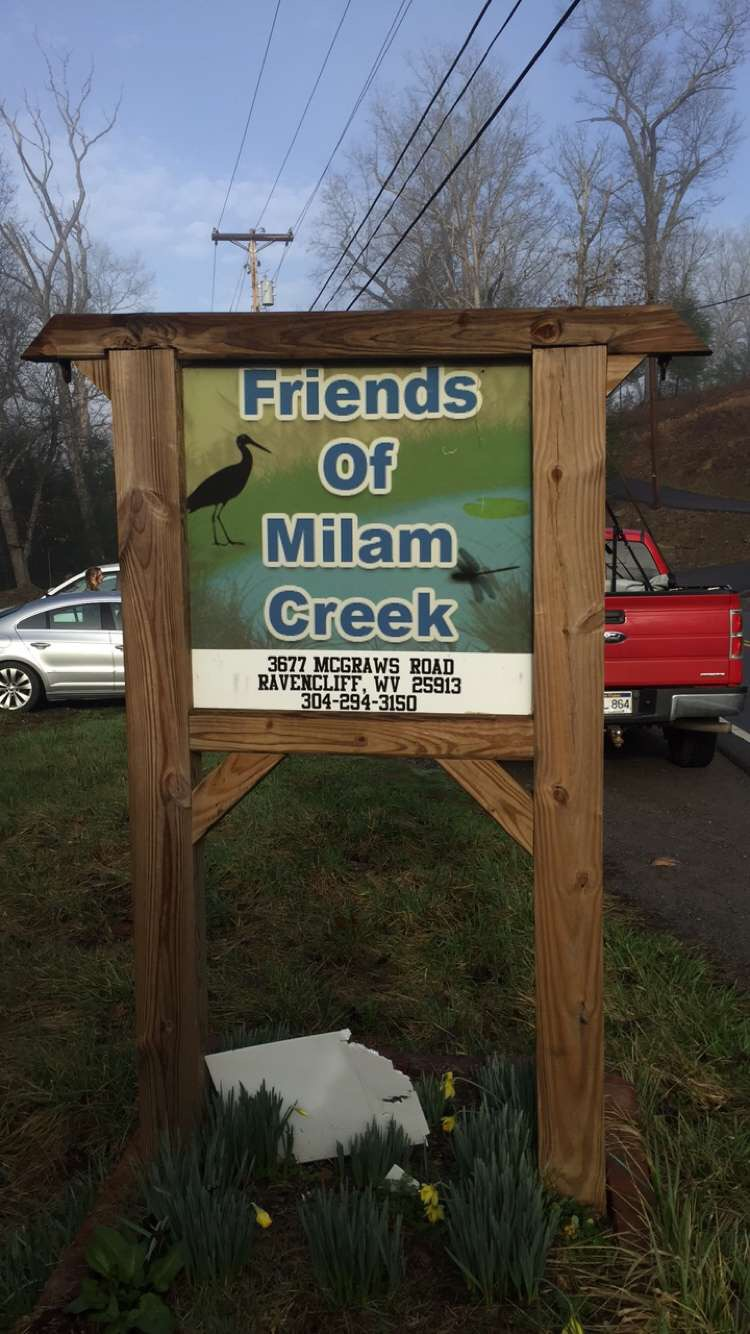 Throughout the week, we worked on several projects around the community. The main location was the Milam Creek House, where the Friends are based. Here, we helped to remove rotten wood from the basement and paint the building. Down the road, we helped to renovate the recently donated community center. This involved setting up electrical wiring and lighting throughout the building, as well as demolishing the old restrooms. Meanwhile, several people cleared invasive plants from the nearby creek bank to make room for a fishing deck. The final major project was the construction of a memorial to the more than 160 miners who died in Glen Rogers mines between 1917 and 1960. We installed a new fence and pathway on site to make way for the stone obelisk that will honor the dead.
Throughout the week, we worked on several projects around the community. The main location was the Milam Creek House, where the Friends are based. Here, we helped to remove rotten wood from the basement and paint the building. Down the road, we helped to renovate the recently donated community center. This involved setting up electrical wiring and lighting throughout the building, as well as demolishing the old restrooms. Meanwhile, several people cleared invasive plants from the nearby creek bank to make room for a fishing deck. The final major project was the construction of a memorial to the more than 160 miners who died in Glen Rogers mines between 1917 and 1960. We installed a new fence and pathway on site to make way for the stone obelisk that will honor the dead.
As we worked, we got to meet many local residents and gained some insight on what it was like to live there. Dave Polk, for example, chatted about what it was like to grow up here. He told us that when he was young there were dozens of bird species in the area, even in winter. The whip-poor-will’s call would announce the arrival of spring, and soon the woods would be full of wildflowers. Now, he explained, the environment has become degraded. He hasn’t seen a whip-poor-will or a wildflower in years, and urbanization has forced remaining wildlife into developed areas. Like many young men, Dave soon found himself working ten to twelve hours a day in the coal mines. Throughout his time working he’s seen many changes in the community, including the end of segregation in the industry. According to Dave, the community as a whole was always far more tolerant of diversity than the mines, where African Americans and European immigrants used to receive very poor treatment until very recently.
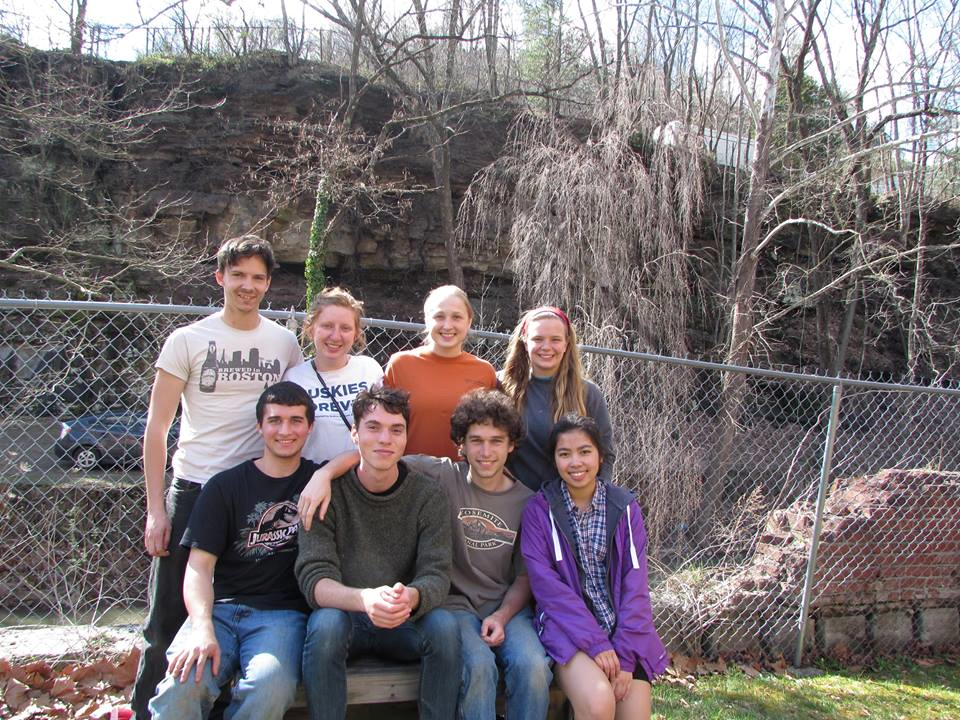
However, when I spoke with Dvon later on the issue of race, she said that to most people coal mining was the ‘great equalizer.’ “One had to depend on the person working next to them for their individual safety. There was no room for prejudice in the mines. While African Americans and European immigrants might have been treated differently outside the mines in other parts of the community, when you were working inside the mines – everyone was someone of color – coal black. Communities DID center somewhat on nationality – but much of that was because of language…and food…and familiarity.”
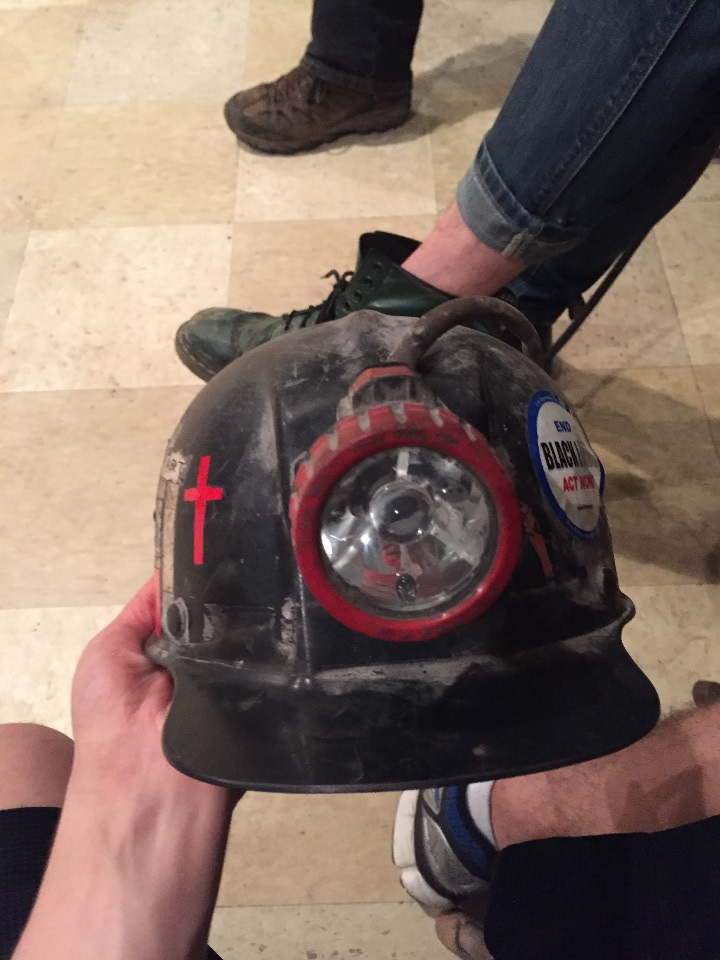
Doug Thorn gave a presentation on his work as a miner and a mine inspector. He showed us the gear that miners carry, including a methane gas detector, oxygen tank for emergencies, and light. Doug then explained that while he worked as an inspector, he came across numerous safety violations from different companies as they tried to avoid regulations. He’s been in court several times to force mines to temporarily shut down as gas or coal dust buildups were drained, and continues to challenge mines on their hazardous conditions. Doug himself has developed black lung, in spite of all the precautions he’s taken over the years.

We also met Jack Spadaro, an expert witness and environmental consultant, who came to speak to us about how he combats these illegal mining activities. He became active after the 1972 Buffalo Creek Flood killed over 120 people and destroyed over 4,000 houses. It was discovered that the flood resulted from leaky dams that filled with coal and metal slurry, then spilled into the valleys below. The pollutants have caused numerous health issues in the victims and birth defects in their children, but for years the mines refused to take responsibility. Some have even illegally hid the documents linking them to the pollutants. Many floods have occurred since 1972, the worst of which destroyed 3,000 more homes in 2001. Jack has worked on hundreds of cases and investigations, many of which have resulted in at least some financial compensation for the victims. However, Jack warns that over 700 reservoirs remain full of mining waste, and many are poorly maintained. There could easily be more disasters in the near future if nothing is done.
Mountaintop Removal
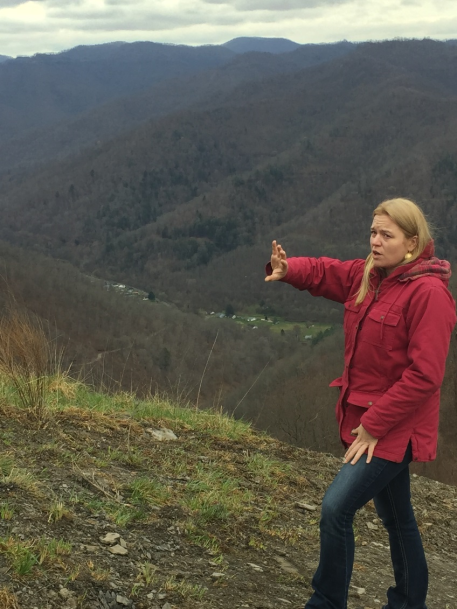
Before leaving West Virginia on Saturday, we got to see the heart of modern environmental devastation in Appalachia. Kayford Mountain, owned and managed by Keeper of the Mountains, is a sliver of protected land surrounded by mountaintop removal. We met with Elise Keaton, who has worked for many years to promote awareness and push for action against the industry. She gave us insight into this now prevalent form of mining.
The shift away from reliance on manpower began in the 1970s, as the growing energy crisis and increasing environmental regulations brought companies to search for more efficient methods of coal extraction. Instead of sending miners underground, companies raze entire forests and level the mountains with explosives. Debris is forced down into the valleys and watersheds, which in turn has caused the heavy flooding in recent decades. Elise showed us several mountains that have lost up to 800 feet of elevation. Diverse forests have been reduced to barren wastelands, and the ground beneath Kayford has begun to crack as the rock destabilizes. Furthermore, the mining is continuing to expand. At this time, 500 mountains have been demolished, and every mountain around Kayford is slated to be removed as well.

In spite of growing up in West Virginia, Elise herself was unaware of mountaintop removal until she was in college. Unfortunately, hundreds of thousands of other people in West Virginia remained uninformed of the devastation going on in their own back yard.
Unfortunately, there are no easy solutions to this crisis. Overall coal production continues to decrease as it’s replaced by natural gas and renewables, but the United States still consumes over 700 million tons of coal per year. As long as there is a demand for coal, the industry will continue to supply. 30-40% of our nation’s energy is currently supplied by coal, and the Department of Defense relies heavily on fossil fuels. And until new industries – energy or otherwise – develop in Appalachia and other coal producing communities throughout the United States, large portions of the population will remain jobless and/or impoverished for the foreseeable future.

There is still hope for the region’s natural environment. When mining companies do follow regulations, hard and soft wood trees and native species can be planted on reclaimed land. Some of that land has been turned over to communities. For example, Dvon recently helped with planting in the Tomblin Wildlife Management Area, managed by the West Virginia Department of Natural Resources. Here, some of the ridgetops have been surface mined and reclaimed to ‘wildlife habitat,’ most recently by Alpha Natural Resources. On top of this, the DNR plans to reintroduce elk to the new preserve. Additionally, in a separate project, Cliffs Natural Resources planted 9,000 trees with help from the two Wyoming County high schools. Here, there is a plan to introduce American chestnut hybrids.
I’m incredibly grateful for my experiences on this trip. I got to bond with other environmentally-minded UConn students, meet the wonderful people of West Virginia, and gain insight into one of the most challenging environmental crises our country faces. I hope to continue to raise awareness of the problems of fossil fuels, and go back to help the residents of Milam Creek in the future.
-Ben
Learn more about the issues surrounding coal mining: http://www.mountainkeeper.org/the-problems/
Find out how much you rely on coal: http://ilovemountains.org/my-connection
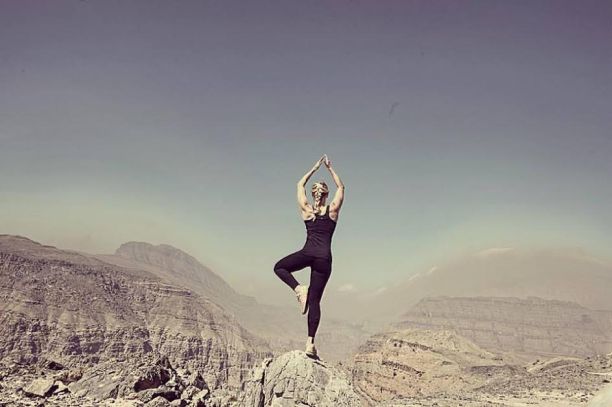 There are two forms of tourism: Tourism (Tourist) and Responsible Tourism (Traveler). The ‘Tourist’ will travel to locations that are relatively safe and within their comfort zone. They’ll expect to stay in a 3-5 star hotels owned by large corporations, embark on tours offered by the hotel, and will typically not veer off the beaten path to unknown locations. They’re knowledge of the local people of that country and their way of life is very limited, and they’re not interested in learning more about it first-hand. They are waited on by local people but that’s about as far as their study of that culture within that country will go. The hotels they stay in don’t necessarily have any sustainability or energy efficiency practices, instead they offer tours such as riding with the dolphins and learning about culture by having a woman come into the resorts event area for a belly dancing show, for example. The ‘Traveler’, on the other hand, will be more open to experience off-the-beaten-path locations and unique experiences that test their limits. They’ll be more supportive of the economies of local cultures (staying in locally owned hotels), spending time learning about the local people and communities, adding to the regeneration of the environment that surrounds them, and trust in their hosts.
There are two forms of tourism: Tourism (Tourist) and Responsible Tourism (Traveler). The ‘Tourist’ will travel to locations that are relatively safe and within their comfort zone. They’ll expect to stay in a 3-5 star hotels owned by large corporations, embark on tours offered by the hotel, and will typically not veer off the beaten path to unknown locations. They’re knowledge of the local people of that country and their way of life is very limited, and they’re not interested in learning more about it first-hand. They are waited on by local people but that’s about as far as their study of that culture within that country will go. The hotels they stay in don’t necessarily have any sustainability or energy efficiency practices, instead they offer tours such as riding with the dolphins and learning about culture by having a woman come into the resorts event area for a belly dancing show, for example. The ‘Traveler’, on the other hand, will be more open to experience off-the-beaten-path locations and unique experiences that test their limits. They’ll be more supportive of the economies of local cultures (staying in locally owned hotels), spending time learning about the local people and communities, adding to the regeneration of the environment that surrounds them, and trust in their hosts. During my travels in St. Lucia, I performed a case study. The island is comprised of at least several “1-800 Sandals” resorts. I wanted just to speak with the people who worked there to get a sense of their clientele and overall sense of happiness. The employees came up to me with a massive smile on their face, willing to answer any questions that I had, offering their input on activities, and the like. I sat down with one of them, Ron, and talked with him for a bit. I’m assuming he told me to call him Ron because it’s easier to pronounce to foreigners. I said, “Hey Ron, I’m not here to vacation, I’m here to learn more about 1-800 Sandal’s sustainability impact and its cultural influence. How do you like working here?”. He took me aside and said, “I can barely keep afloat, I work long hours, I’m overworked and don’t make enough to provide for my family. But it’s a job.” I asked, “Do the guests want to learn about your culture, where you’re from in St. Lucia?”, Ron responded, “No, they’re here for a vacation! They don’t want to learn about that type of stuff while they vacation here”, he said with a chuckle. I paid $70 for a dinner which granted me access to walk inside the premise. There were couples, mainly from Western areas of the world, and many from the US. I observed as they enjoyed their vacation, never leaving the resorts premises. They drank their Mojitos and Piña Coladas and enjoyed their Honeymoons, never once engaging in conversation with the people who worked for them. If they did, it was to show whoever it was they were Facetiming with, the idea that they were mingling with the local people when in reality, they weren’t. Meanwhile, the employees worked diligently to ensure a perfect vacation for their guests. They had the typical, “Save water, use less” signs located in the bathrooms, but in regards to their sustainability protocol, that was about it. In a place that receives an average of 9 hours of sunlight a day, they had no solar panels. They had no tours where guests had the opportunity to learn about the local culture. They had no reverse osmosis system or wildlife/ecology conservation program, which could easily be implemented given the vast capital that this resort chain endows. I went back to my locally owned lodge near the airport to digress. If these resorts focused on their sustainability message, the people who vacationed there would not only experience a luxurious vacation, but they’d walk away having contributed to the greater good of the environment and local culture. A feel good, do good vacation. There needs to be a major shift in the way we travel, and regenerative tourism has to be it.
During my travels in St. Lucia, I performed a case study. The island is comprised of at least several “1-800 Sandals” resorts. I wanted just to speak with the people who worked there to get a sense of their clientele and overall sense of happiness. The employees came up to me with a massive smile on their face, willing to answer any questions that I had, offering their input on activities, and the like. I sat down with one of them, Ron, and talked with him for a bit. I’m assuming he told me to call him Ron because it’s easier to pronounce to foreigners. I said, “Hey Ron, I’m not here to vacation, I’m here to learn more about 1-800 Sandal’s sustainability impact and its cultural influence. How do you like working here?”. He took me aside and said, “I can barely keep afloat, I work long hours, I’m overworked and don’t make enough to provide for my family. But it’s a job.” I asked, “Do the guests want to learn about your culture, where you’re from in St. Lucia?”, Ron responded, “No, they’re here for a vacation! They don’t want to learn about that type of stuff while they vacation here”, he said with a chuckle. I paid $70 for a dinner which granted me access to walk inside the premise. There were couples, mainly from Western areas of the world, and many from the US. I observed as they enjoyed their vacation, never leaving the resorts premises. They drank their Mojitos and Piña Coladas and enjoyed their Honeymoons, never once engaging in conversation with the people who worked for them. If they did, it was to show whoever it was they were Facetiming with, the idea that they were mingling with the local people when in reality, they weren’t. Meanwhile, the employees worked diligently to ensure a perfect vacation for their guests. They had the typical, “Save water, use less” signs located in the bathrooms, but in regards to their sustainability protocol, that was about it. In a place that receives an average of 9 hours of sunlight a day, they had no solar panels. They had no tours where guests had the opportunity to learn about the local culture. They had no reverse osmosis system or wildlife/ecology conservation program, which could easily be implemented given the vast capital that this resort chain endows. I went back to my locally owned lodge near the airport to digress. If these resorts focused on their sustainability message, the people who vacationed there would not only experience a luxurious vacation, but they’d walk away having contributed to the greater good of the environment and local culture. A feel good, do good vacation. There needs to be a major shift in the way we travel, and regenerative tourism has to be it. Two continents away was another resort I’d visited. Located at the tip of the Oman peninsula, nestled on the northern Musandam Peninsula and facing the Arabian sea, is the 5 star, Six Senses Zighy Bay Resort. The guests who visit this particular resort must be willing to venture way out into the Middle East. They have to be open to traveling two hours from the Dubai Airport by car, through the desert of UAE and Oman to get to this very secluded resort deep within the mountainous rifts. I took a seat next to Manuel, the Organic Garden intern at Six Senses. He traveled there from Germany. “How much of the garden is factually organic? In my experience, it’s challenging to harvest an organic garden over 80% to serve a hotel.”, I asked. Manuel said, “It’s a 95-98% organic garden that supplies much of the produce for the resort”. There is a compost system, a reverse osmosis irrigation system and the resort has plans to install solar panels in the near future. In every room, the guests can purchase a cute little Zighy goat stuffed animal where 100% of the proceeds go to the local schools. They also have cultural tours to the mountains and communities, where guests have the opportunity to visit the families who live in the surrounding areas. I took a ride with one of the guides and had the opportunity to meet Mohammed, a man from Pakistan who lived high up in the mountains. “I chose to live here for peace and serenity.”, Mohammed said. Every day, he climbs 100 stairs just to get to the top, where his rustic house is.
Two continents away was another resort I’d visited. Located at the tip of the Oman peninsula, nestled on the northern Musandam Peninsula and facing the Arabian sea, is the 5 star, Six Senses Zighy Bay Resort. The guests who visit this particular resort must be willing to venture way out into the Middle East. They have to be open to traveling two hours from the Dubai Airport by car, through the desert of UAE and Oman to get to this very secluded resort deep within the mountainous rifts. I took a seat next to Manuel, the Organic Garden intern at Six Senses. He traveled there from Germany. “How much of the garden is factually organic? In my experience, it’s challenging to harvest an organic garden over 80% to serve a hotel.”, I asked. Manuel said, “It’s a 95-98% organic garden that supplies much of the produce for the resort”. There is a compost system, a reverse osmosis irrigation system and the resort has plans to install solar panels in the near future. In every room, the guests can purchase a cute little Zighy goat stuffed animal where 100% of the proceeds go to the local schools. They also have cultural tours to the mountains and communities, where guests have the opportunity to visit the families who live in the surrounding areas. I took a ride with one of the guides and had the opportunity to meet Mohammed, a man from Pakistan who lived high up in the mountains. “I chose to live here for peace and serenity.”, Mohammed said. Every day, he climbs 100 stairs just to get to the top, where his rustic house is. The primary focus of Expedition 196 is to generate awareness within the tourism sector. To deter travelers from the traditional experience, and focus more on the development of regenerative hotels and tour companies, in order to reverse damage to the environment and save endangered species and cultures who are suffering. Traveling “Sustainably” doesn’t have to mean the letting go of things that provide comfort to the average traveler. That’s what rustic travel is for; to give up certain elements that make a person comfortable, in order to experience a truly authentic, and surreal experience, with traditional essences of normality, left behind. Sustainability and moreover, regenerative tourism provides an opportunity for the traveler to reduce their carbon footprint, while making friends with the local people. Sure, they might have to give up their Herbal Essences shampoo in order to use the biodegradable shampoo and soaps provided by the hotel (if they do so choose), but it’s a do-good-feel-good experience that should add to the overall authenticity of their vacation. Sustainable/Regenerative resorts, lodges and hotels can range from $10/night to $10,000/night. This form of travel appeals to all types of travelers and that’s the best thing about it. There’s really no excuse to not travel in this way.
The primary focus of Expedition 196 is to generate awareness within the tourism sector. To deter travelers from the traditional experience, and focus more on the development of regenerative hotels and tour companies, in order to reverse damage to the environment and save endangered species and cultures who are suffering. Traveling “Sustainably” doesn’t have to mean the letting go of things that provide comfort to the average traveler. That’s what rustic travel is for; to give up certain elements that make a person comfortable, in order to experience a truly authentic, and surreal experience, with traditional essences of normality, left behind. Sustainability and moreover, regenerative tourism provides an opportunity for the traveler to reduce their carbon footprint, while making friends with the local people. Sure, they might have to give up their Herbal Essences shampoo in order to use the biodegradable shampoo and soaps provided by the hotel (if they do so choose), but it’s a do-good-feel-good experience that should add to the overall authenticity of their vacation. Sustainable/Regenerative resorts, lodges and hotels can range from $10/night to $10,000/night. This form of travel appeals to all types of travelers and that’s the best thing about it. There’s really no excuse to not travel in this way.